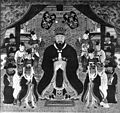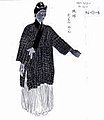Ryusou: Difference between revisions
Gyuligula2 (talk | contribs) New page: Ryusou |
(No difference)
|
Revision as of 05:37, 24 December 2021

Ryusou (琉装; りゅうそう; also written as ryuso), also referred as Ushinchi or uchina-asugai in Okinawan dialect, is the traditional dress of the Okinawans.[1][2][3] Ryusou is a form of formal attire; it is customary to wear it on occasions such as wedding ceremony and the coming-of-age ceremony. [2] The ryusou became popular during the Ryukyu Kingdom period.[2] It was originally worn by the members of the royal family and by the nobles of Ryukyu.[2] The development of the ryusou was influenced by both the hanfu and the kimono.[2]
History
The Ryukyu was originally an independent nation which established trade relationship with many countries in Southeast Asia (Java, Malacca, and Palembang) and East Asia; they held their relationship with China as especially important.[4] Tributary relationships with the Ming dynasty was established in 1372 by the three kingdoms of Sanzan.[5]
In 1372, the King of Chuzan entered into a tributary relationship with the Ming dynasty and paid tribute for 500 years for trading privileges and diplomatic ties.[4] In exchange for their tributes, the Ming dynasty granted Ryukyu with Ming dynasty clothing of various designs (including round collar robe and cross-collared robe), silk and royal crown.[6][7] During the reign of King Sho Shin, a decree was made in an effort to codify and ritualize the dress code as an expression of one's social status and ranks; colours were then used to distinguish the upper and lower ranks, thus defining the elite identity in Ryukyu Kingdom.[7] This decree by King Sho Shin was a situation where Chinese practices were localized in the Ryukyu Kingdom.[7] The regal insignia was a Ryukyuan innovation which was loosely based on the Ming dynasty regulations of dress codification.[7] Following the fall of the Ming dynasty, the Ryukyu continued to follow the Ming dynasty's court fashion and styled their own clothing with dragon emblems which was bestowed by the Qing dynasty.[8]
Chinese silks which was bestowed were also transformed by the local artisans in Ryukyu to make ceremonial garments; those silk ceremonial garments differed from the hemp-based clothing that most commoners would make as their clothing.[7] Red kakan (裙), a form of pleated underskirt, is believed to have been worn under a ceremonial attire called touishou (also known as hibenfuku or umanton[9]) which was gifted by the Ming dynasty emperors.[10] The touishou was a winter ceremonial clothing for the Kings.[9] The touishou was slightly modified from the cloth that was gifted by the Ming dynasty in getting unique Ryukyuan features (i.e. fringes at the back of the garment) while maintaining the style of Ming dynasty court clothing.[9] Men undergarment consisted of white silk dujin (胴衣; cross-collared upper clothing which closes to the right) and white silk trousers; only members of the royal family and members of upper-class warrior families were allowed to wear these undergarments.[11] The emperor also wore dujin and trousers as undergarments under his touishou.[11] The combination of dujin and kakan was also worn as a ceremonial costume for women who came from warrior families.[12] Dujin and kakan continued to be worn in Ryukyu at least until the Meiji period.[13]
-
King of Chūzan and his sons
-
King Sho Shin
-
King Sho Kei
-
Ryukyu people, from the Sekaijimbutsu emaki (世界人物図巻), possibly beginning of Edo period.
-
dujin and kakan
-
Ryukyu clothing, 1721.
-
Replica of the crown of the Kings of Ryukyu
After Satsuma subjugated the Ryuku islands in 1609, Satsuma controlled the islands and intentionally ceded to China's ritual authority over the Ryukyu kingdom in order to win the economic profit from the tribute trade with China.[4] The Ryukyu kingdom continued to pay tribute to the Ming and Qing dynasties in China,[6] but they were also forced to pay tribute to the Shogun as well.[5] In order to hide the dual sovereignty, the Ryukyuans were forbidden from assimilated into Japanese culture and they were encouraged to continue wearing their traditional clothing and speaking their Ryukyuan dialect.[4][14] And, when the envoys of Ryukyu would go to missions to Edo, they had to wear Chinese clothing.[14]
The Ryukyu kingdom was eventually abolished and the islands were annexed without consent by the Meiji government.[4] Between the year 1879 to 1895, many cultural and institutional characteristics of the Ryuku kingdom were preserved.[15] However, following the arrival of Governor Shigeru Narahara, a aggressive form of cultural assimilation took place in the form of Japanization; leading to the Ryuku traditional clothing to be discouraged.[15]
-
Ryukyu people, Edo period.
-
Traditional Ryukyuan clothes, 19th century.
-
Ryukyu woman, 19th century.
-
Ryukyu robe made of bingata, 19th century
Construction and design
During the Ryukyu kingdom period, colour, fabric and design of the ryusou was used to distinguished the social status and rank of his wearer.[2][3] Men's ryusou is also different from the women's ryusou in terms of colour, design, and material.[2] The ryusou for women is based on the bingata motif.[2] The bingata has bright colors; it is a form of textile which was traditionally reserved for the royalty of Ryukyu.[3]
Ryusou is made of high quality plain woven hemp fabric which is called Joufu.[2]
Differences with Kimono
Due to the climatic differences, Okinawans did not have the same style of clothing as the ones worn in mainland Japan.[3] Compared to the kimono, the ryusu has big sleeves openings which allows for good air circulation.[2] The ryusou also uses a thin waistband instead of the obi which is used in the kimono.[3] The ryusou is also very light light, mobile and loosely tailored compared to the kimono.[2][3]
References
- ^ Astroth, Alexander (2019). Mass suicides on Saipan and Tinian, 1944 : an examination of the civilian deaths in historical context. Jefferson, North Carolina. p. 48. ISBN 978-1-4766-7456-8. OCLC 1049791315.
{{cite book}}: CS1 maint: location missing publisher (link) - ^ a b c d e f g h i j k "Traditional Costume that Represents Okinawa's Culture and National Features, the "Ryusou". | Features | Okinawa Travel Info". okinawatravelinfo.com. Retrieved 2021-12-24.
- ^ a b c d e f "10 Must-Try Traditional Okinawan Experiences". VISIT OKINAWA JAPAN | Official Okinawa Travel Guide (in Japanese). Retrieved 2021-12-24.
- ^ a b c d e Native peoples of the world : an encyclopedia of groups, cultures, and contemporary issues. Steven Laurence Danver. Armonk, NY: Sharpe Reference, an imprint of M.E. Sharpe, Inc. 2013. p. 235. ISBN 978-0-7656-8294-9. OCLC 827552799.
{{cite book}}: CS1 maint: others (link) - ^ a b Howard, Michael C. (2012). Transnationalism in ancient and medieval societies : the role of cross-border trade and travel. Jefferson, N.C.: McFarland. p. 151. ISBN 978-0-7864-9033-2. OCLC 779849477.
- ^ a b Self-determinable Development of Small Islands. Masahide Ishihara, Eiichi Hoshino, Yōko Fujita. Singapore. 2016. p. 56. ISBN 978-981-10-0132-1. OCLC 952246912.
{{cite book}}: CS1 maint: location missing publisher (link) CS1 maint: others (link) - ^ a b c d e KIT, CHAN YING (2010-08-16). A Bridge between Myriad Lands: The Ryukyu Kingdom and Ming China (1372-1526) (Thesis thesis).
- ^ Akamine, Mamoru (2017). The Ryukyu Kingdom : cornerstone of East Asia. Lina Terrell, Robert N. Huey. Honolulu. pp. 128–129. ISBN 978-0-8248-5520-8. OCLC 964698884.
{{cite book}}: CS1 maint: location missing publisher (link) - ^ a b c "Chinese style ceremonial costume. : Naha City Historical Museum". www.rekishi-archive.city.naha.okinawa.jp. Retrieved 2021-12-24.
- ^ "Costume: Red ground satin. Silk. : Naha City Historical Museum". www.rekishi-archive.city.naha.okinawa.jp. Retrieved 2021-12-24.
- ^ a b "Costume: White ground satin. Silk. (Undergarment and Pants-like garment) : Naha City Historical Museum". www.rekishi-archive.city.naha.okinawa.jp. Retrieved 2021-12-24.
- ^ "Costume in BINGATA dyed. : Naha City Historical Museum". www.rekishi-archive.city.naha.okinawa.jp. Retrieved 2021-12-24.
- ^ Hendrickx, Katrien (2007). The origins of banana-fibre cloth in the Ryukyus, Japan. Leuven [Belgium]: Leuven University Press. pp. 118–119. ISBN 978-94-6166-049-7. OCLC 715172043.
- ^ a b McCormack, Gavan (2018). Resistant Islands : Okinawa Confronts Japan and the United States. Satoko Oka Norimatsu (Second ed.). Lanham. p. 251. ISBN 978-1-4422-1563-4. OCLC 1089884872.
{{cite book}}: CS1 maint: location missing publisher (link) - ^ a b The international handbook of the demography of race and ethnicity. Rogelio Saenz, David G. Embrick, Néstor Rodriguez. Dordrecht. 2015. p. 228. ISBN 978-90-481-8891-8. OCLC 910845577.
{{cite book}}: CS1 maint: location missing publisher (link) CS1 maint: others (link)











